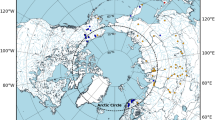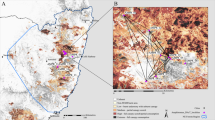Abstract
Regional scale conservation decisions can be aided by information on the distribution of intraspecific diversity, especially the extent to which patterns are common to multiple species. We compare patterns of intraspecific mitochondrial cytochrome oxidase I (COI) variation among three flightless beetles (Coleoptera: Tenebrionidae: Nyctoporis carinata LeConte; Staphylinidae: Sepedophilus castaneus (Horn); Carabidae: Calathus ruficollis Dejean) in the southern part of the California Floristic Province biodiversity hotspot. All species exhibit moderate to high levels of total variation, ranging from 2% to 10% (maximum uncorrected distance). Most populations of all species exhibit unique haplotypes, but few populations’ haplotypes constitute exclusive clades. Many adjacent pairs of populations show indications of some, though limited, genetic connectedness, due either to gene flow or ancestral polymorphism. However, in most cases this diminishes sharply over greater distances. By both statistical and phylogenetic measures, Sierra Nevadan populations are highly distinct from those in the coast and transverse ranges. Among the latter, the eastern transverse ranges are generally most unique and isolated, with diversity in the western parts of these ranges showing fewer barriers. Otherwise, few measures agree on areas of highest conservation value, and overall patterns tend to be species-specific.



Similar content being viewed by others
References
Bolger DT, Suarez AV, Crooks KR, Morrison SA, Case TJ (2000) Arthropods in urban habitat fragments in southern California: area, age, and edge effects. Ecol Applic 10:1230–1248
Bond JE (2004) Systematics of the Californian euctenizine spider genus Apomastus (Araneae: Mygalomorphae: Cyrtaucheniidae): the relationship between molecular and morphological taxonomy. Invertebr Syst 18:361–376
Calsbeek R, Thompson JN, Richardson JE (2003) Patterns of molecular evolution and diversification in a biodiversity hotspot: the California Floristic Province. Mol Ecol 12:1021–1029
Casgrain P (2001) Permute! v3.4α9. University of Montreal, Montreal
Caterino MS (2006) California beetle faunistics: 100 years after Fall. Coleopt Bull 60:177–191
Caterino MS, Cho S, Sperling FAH (2000) The current state of insect molecular systematics: a thriving Tower of Babel. Annu Rev Entomol 45:1–54
CDFG (2007) Natural Community Conservation Planning. http://www.dfg.ca.gov/nccp. Cited 13 July 2007
Chatzimanolis S, Caterino MS (2007a) Limited phylogeographic structure in a flightless ground beetle, Calathus ruficollis, in southern California. Divers Distrib 13:498–509
Chatzimanolis S, Caterino MS (2007b) Toward a better understanding of the ‘Transverse Range Break’: lineage diversification in southern California. Evolution 61:2127–2141
Dobson AP, Rodriguez JP, Roberts WM, Wilcover DW (1997) Geographic distribution of endangered species in the United States. Science 275:550–553
Excoffier L, Smouse PE, Quattro JM (1992) Analysis of molecular variance inferred from metric distances among DNA haplotypes—application to human mitochondrial-DNA restriction data. Genetics 131:479–491
Excoffier L, Laval G, Schneider S (2005) ARLEQUIN ver. 3.0: an integrated software package for population genetics data analysis. Evol Bioinf Online 1:47–50
Felsenstein J (1981) Evolutionary trees from DNA sequences: a maximum-likelihood approach. J Mol Evol 17:368–376
Fisher RN, Suarez AV, Case TJ (2002) Spatial patterns in the abundance of the Coastal Horned Lizard. Conserv Biol 16:205–215
Forest F, Grenyer R, Rouget M, Davies TJ, Cowling RM, Faith DP, Balmford A, Manning JC, Procheş Ş, van der Bank M, Reeves G, Hedderson TAJ, Savolainen V (2007) Preserving the evolutionary potential of floras in biodiversity hotspots. Nature 445:757–760
Frankham R (1995) Conservation genetics. Annu Rev Genet 29:305–327
Fu YX (1997) Statistical tests of neutrality of mutations against population growth, hitchhiking and background selection. Genetics 147:915–925
Harden DR (2004) California geology. Prentice Hall, Upper Saddle River, NJ
Hickman JC (1993) The Jepson manual: higher plants of California. University of California Press, Berkeley, CA
Huelsenbeck JP, Ronquist F (2001) MRBAYES: Bayesian inference of phylogenetic trees. Bioinformatics 17:754–755
Jensen, JL, Bohonak, AJ, Kelley, ST (2005) Isolation by distance, web service. BMC Genetics 6: 13. v.3.15 (http://ibdws.sdsu.edu/). Accessed November 2007
Kuhner MK, Yamato J, Felsenstein J (1998) Maximum likelihood estimation of population growth rates based on the coalescent. Genetics 149:429–434
Landry B, Powell JA, Sperling FAH (1999) Systematics of the Argyrotaenia franciscana (Lepidoptera: Tortricidae) species group: evidence from mitochondrial DNA. Ann Entomol Soc Am 92:40–46
Law JH, Crespi BJ (2002) The evolution of geographic parthenogenesis in Timema walking-sticks. Mol Ecol 11:1471–1489
Moritz C (1994) Application of mitochondrial DNA analysis in conservation: a critical review. Mol Ecol 3:401–411
Moritz C, Faith DP (1998) Comparative phylogeography and the identification of genetically divergent areas for conservation. Mol Ecol 7:419–429
Myers N, Mittermeier RA, Mittermeier CG, da Fonseca GAB, Kent J (2000) Biodiversity hotspots for conservation priorities. Nature (London) 403:853–858
Newman D, Tallmon DA (2001) Experimental evidence for beneficial fitness effects of gene flow in recently isolated populations. Conserv Biol 15:1054–1063
Posada D (2006) ModelTest Server: a web-based tool for the statistical selection of models of nucleotide substitution online. Nucleid Acids Res 34:W700–W703
Riley SPD, Busteed GT, Kats LB, Vandergon TL, Lee LFS, Dagit RG, Kerby JL, Fisher RN, Sauvajot RM (2005) Effects of urbanization on the distribution and abundance of amphibians and invasive species in southern California streams. Conserv Biol 19:1894–1907
Rissler LJ, Hijmans RJ, Graham CH, Moritz C, Wake DB (2006) Phylogeographic lineages and species comparisons in conservation analyses: a case study of California herpetofauna. Am Nat 167:655–666
Rubinoff D (2001) Evaluating the California Gnatcatcher as an umbrella species for conservation of southern California coastal sage scrub. Conserv Biol 15:1374–1383
Rundel PW, King JA (2001) Ecosystem processes and dynamics in the urban/wildland interface of southern California. J Mediterr Ecol 2:209–219
Schwartz MW, Thorne JH, Viers JH (2006) Biotic homogenization of the California flora in urban and urbanizing regions. Biol Conserv 127:282–291
Seabloom EW, Williams JW, Slayback D, Stoms DM, Viers JH, Dobson AP (2006) Human impacts, plant invasion, and imperiled plant species in California. Ecol Applic 16:1338–1350
Seagraves KA, Pellmyr O (2001) Phylogeography of the yucca moth Tegeticula maculata: the role of historical biogeography in reconciling high genetic structure with limited speciation. Mol Ecol 10:1247–1253
Suarez AV, Bolger DT, Case TJ (1998) The effects of fragmentation and invasion on the native ant community in coastal southern California. Ecology 79:2041–2056
Syphard AD, Clarke KC, Franklin J (2005) Using a cellular automaton model to forecast the effects of urban growth on habitat patterns in southern California. Ecol Complexity 2:185–203
Syphard AD, Franklin J, Keeley JE (2006) Simulating the effects of frequent fire on southern California coastal shrublands. Ecol Applic 16:1744–1756
Tajima F (1989) The effect of change in population-size on DNA polymorphism. Genetics 123:597–601
Tamura K, Nei M (1993) Estimation of the number of nucleotide substitutions in the control region of mitochondrial-DNA in humans and chimpanzees. Mol Biol Evol 10:512–526
Vandergast AG, Bohonak AJ, Weissman DB, Fisher RN (2007) Understanding the genetic effects of recent habitat fragmentation in the context of evolutionary history: phylogeography and landscape genetics of a southern California endemic Jerusalem cricket (Orthoptera: Stenopelmatidae: Stenopelmatus). Mol Ecol 16:977–992
Wilcox BA, Murphy DD (1985) Conservation strategy: the effects of fragmentation and extinction. Am Nat 125:879–887
Acknowledgments
We appreciate the assistance of A. Ramsdale, R. Aalbu, K. Will, S. Mulqueen, P. Russell, P. Jump, and I. Foley in collecting or providing specimens, and that of G. Betzholtz in the lab. Several preserves, agencies (and their personnel) generously granted collecting permission and otherwise provided assistance: the California Department of Fish and Game, Los Padres National Forest (M. Freel), the UC Sedgwick Reserve (M. Williams), the Arroyo Hondo Preserve (Land Trust for Santa Barbara County, C. Chapman, J. Iwerks, J. Dunn, and J. Warner), UC Whitaker Forest (R. York), Sequoia National Forest (J. White), Camp Cedar Falls (R. Young), Angeles National Forest and the San Dimas Experimental Forest (M. Oxford), San Bernardino National Forest (M. Lardner, R. Eliason), the UC James Reserve (M. Hamilton), the UC Coal Oil Point Reserve (C. Sandoval), and the UC Santa Cruz Island Reserve (L. Laughrin). This work was supported by the Schlinger Foundation, a bequest from G. Oostertag, and National Science Foundation award DEB0447694 to M. Caterino.
Author information
Authors and Affiliations
Corresponding author
Appendices
Appendices
Rights and permissions
About this article
Cite this article
Caterino, M.S., Chatzimanolis, S. Conservation genetics of three flightless beetle species in southern California. Conserv Genet 10, 203–216 (2009). https://doi.org/10.1007/s10592-008-9548-7
Received:
Accepted:
Published:
Issue Date:
DOI: https://doi.org/10.1007/s10592-008-9548-7




